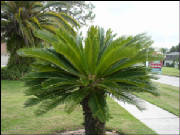Every once in a while I find an article that I have written that needs repeating. If you have pets, this one could
be of importance to you. We have a new puppy, so I was interested in what plants that we have in our house and landscape
that could cause a problem for Hannah.
There are some plants that we use in our Florida landscapes that can
be deadly if consumed by

pets; azaleas, cycads or sago palms, and oleanders. Others can make animals sick. We are usually familiar with
the Dieffenbachia or dumb cane dangers since they affect humans too. Chewing on this plant can lead to suffocation because
the Calcium Oxalate crystals in the plant tissues cause the throat to swell. But, there are many more common plants
that are used in the landscape and as house plants that can cause distress for our pets. Some of the common plants are aloe,
amaryllis, caladium, peace lily, calla lily, elephant ears, philodendron, antherium, and pothos. Cats are particularly sensitive
to lilies like amaryllis, daylily and crinum. Other plants that we use in our landscapes that can be toxic include; dracaena,
kalanchoe, hydrangea, lantana, yucca and iris. Even tomato plants are toxic.
The Veterinary Pet
Insurance Company's list of top 10 plant poisoning claims includes fruits and plant parts. While raisins and grapes caused
the most problems along with some other edibles, many of our familiar plants are on the list.
-
Number 4 is Lily - the poisonous component for cats has apparently not been identified,
 even ingestions of very small amounts of a lily plant could result in severe kidney damage.
even ingestions of very small amounts of a lily plant could result in severe kidney damage. - Number 7 is Sago
Palm - All parts are poisonous, but the seeds contain the largest danger. The ingestion of just one or two seeds can result
in vomiting, diarrhea, depression, seizures and liver failure.
- Number 9 is Azalea - ingestion of a few leaves can
result in serious effects that typically occur within a few hours after ingestion, and can include acute digestive upset,
excessive drooling, loss of appetite, frequent bowel movements/diarrhea, colic, depression, weakness, loss of coordination,
stupor, and leg paralysis.
- Number 10 is Hydrangea - ingesting parts of this plant can result in a gastrointestinal
disturbance with vomiting, depression, and diarrhea.
If you have pets and also have any of these problem
plants, use common sense. If your pet does not usually chew on plants, then it shouldn't be a problem. If you
have a dog or cat that likes to dig, then Amaryllis, caladiums, and other bulbs may not be appropriate for your landscape
since they might dig them up and decide to chew on them. You could consider removing the toxic plants or fencing the
area off to the pet. Several of the plants I listed are also used as house plants and that could create a problem.
Sometimes animals, especially dogs, which are bored, will chew just for the fun of it. If you choose to keep the plants,
familiarize yourself with the symptoms that a pet may show if they ingest one of these plants and seek help immediately if
your pet shows any of these symptoms.
This list is not complete. If you are concerned about any plants, do some
research at the library or on the Internet. The ASPCA web site has comprehensive searchable information about plants that
are toxic or non-toxic to pets: https://www.aspca.org/pet-care/animal-poison-control/toxic-and-non-toxic-plants . If you still have questions consult with your veterinarian.

